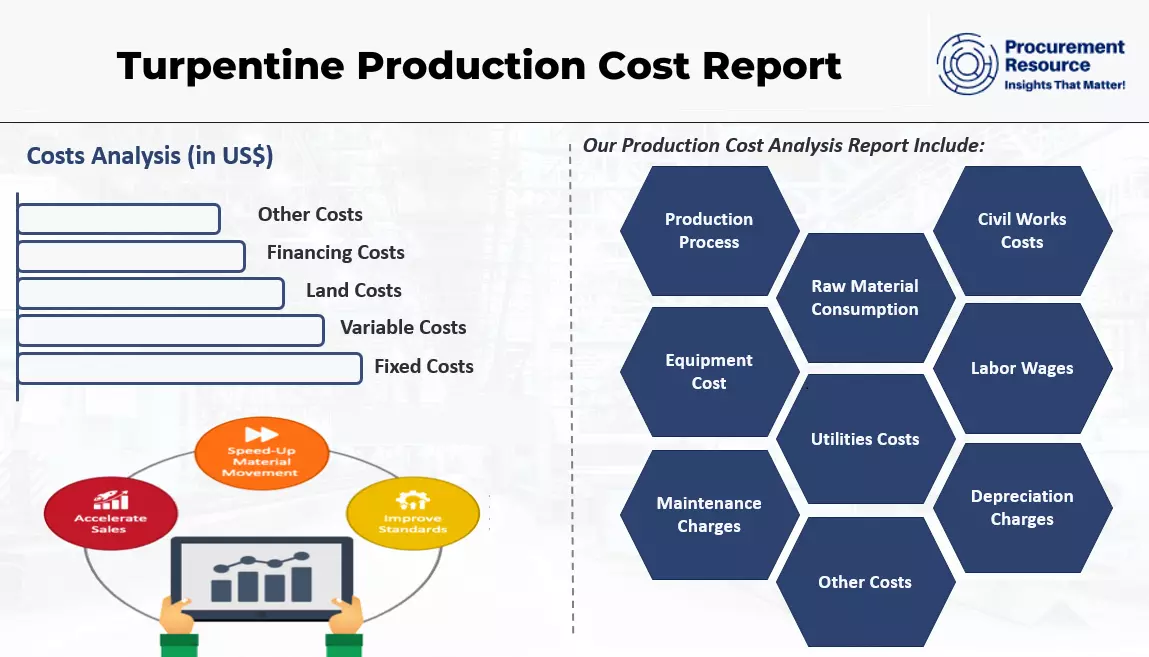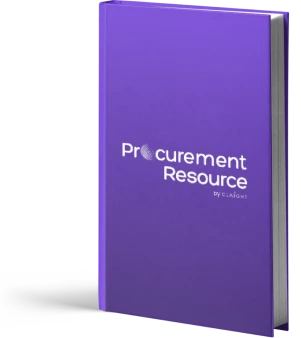Turpentine Production Cost Reports
Flavours and Fragrances
The report provides a detailed analysis essential for establishing a Turpentine manufacturing plant. It encompasses all critical aspects necessary for Turpentine production, including the cost of Turpentine production, Turpentine plant cost, Turpentine production costs, and the overall Turpentine manufacturing plant cost. Additionally, the study covers specific expenditures associated with setting up and operating a Turpentine production plant. These encompass manufacturing processes, raw material requirements, utility requirements, infrastructure needs, machinery and technology requirements, manpower requirements, packaging requirements, transportation requirements, and more.

Turpentine is a solvent used to manufacture paints and coatings, which are utilized in industries such as construction and automotive. It is also used to clean brushes and equipment used in painting. In addition to its industrial uses, Turpentine has medicinal applications; it has antibacterial, anti-inflammatory, and analgesic properties, which makes it useful to treat minor aches and pains, as well as conditions like myiasis when applied topically. Furthermore, turpentine oil is employed in the cosmetics industry for its fragrance and cleaning properties and can be used as a flavoring agent in food products. It also finds applications in the textile industry for dyeing processes and as a degreasing agent in manufacturing.
The market for Turpentine is driven by its usage as a natural ingredient in various formulations, such as disinfectants and antiseptics, which elevates its demand in the pharmaceutical and medical industries. Its utilization as an eco-friendly and natural solvent and thinning agent in paints and coatings boost its market growth. Its usage as a natural fragrance component and active ingredient in various products, such as soaps, detergents, and perfumes, fuels its demand in the personal care and cosmetics industries.
The globalization of industries has led to the interconnection of economies and their supply chain, which further promotes the market for Turpentine. Also, its function as a natural base for essential oils and perfumes contributes to its market growth in the fragrance industry. Additionally, industrial Turpentine procurement is propelled due to its natural and renewable characteristics, which makes it a preferred choice for manufacturers requiring eco-friendly and bio-based raw materials.
Raw Material for Turpentine Production
According to the Turpentine manufacturing plant project report, the key raw materials used in the production of Turpentine include pine trees.
Manufacturing Process of Turpentine
The extensive Turpentine production cost report consists of the following major industrial manufacturing process:
- Production from pine trees: The manufacturing of Turpentine occurs via various methods involving the extraction and distillation of resin from pine trees. Gum turpentine is obtained by tapping living trees to collect resin, followed by steam distillation to separate turpentine oil from gum rosin. Wood turpentine is obtained via steam distillation of dead pine wood or stumps. Sulfate turpentine is a by-product of the kraft process used in paper manufacturing, where wood chips are cooked with chemicals to release turpentine vapors that are collected and condensed. The resulting turpentine oil is further purified for future use.
Turpentine is a liquid made by distilling the resin of pine trees and other conifers. Terpenes such as alpha-pinene, beta-pinene, and delta-3-carene are the major components of turpentine oil. High amounts of Turpentine can be dangerous and even toxic if consumed or inhaled. The molecular formula of Turpentine is C10H16, and its molecular weight is 136.23 g/mol. The melting point of Turpentine is -55°C, and its boiling point ranges between 156°C -165°C. It is soluble in alcohol, ether, and other organic solvents but insoluble in water. It has a low flash point and is flammable in nature. It should be handled and stored with care. The density of Turpentine ranges between 0.86-0.87 g/cm³.
Turpentine Production Cost Processes with Cost Analysis

Turpentine Production from Natural Resins From Pine Trees
The study offers a detailed cost analysis of Turpentine Production from Natural Resins From Pine Trees. In addition, the report incorporates the manufacturing process with detailed process and material flow, operating costs along with financial expenses and depreciation charges.
Details: Germany - based plant Q1 2025 From $ 2499.00 USD
Product Details
| Particulars | Details |
|---|---|
| Product Name | Turpentine |
| Scope | Manufacturing Process: Process Flow, Material Flow, Material Balance Raw Material and Product Specifications: Raw Material Consumption, Product and Co-product Generation Land and Site Cost: Offsites/Civil Works, Equipment Cost, Auxiliary Equipment Costs, Contingency, Engineering and Consulting Charges, Working Capital Variable Cost: Raw Material, Utilities, Other Variable Costs Fixed Cost: Labor Requirements and Wages, Overhead Expenses, Maintenance Charges, Other Fixed Costs Financing Costs: Interest on Working Capital, Interest on Loans Other Costs: Depreciation Charges, General Sales and Admin Cost |
| Currency | US$ (Data can also be provided in the local currency) |
| Pricing and Purchase Options | Basic: US$ 2499 Premium: US$ 3499 Enterprise: US$ 4799 |
| Customization Scope | The report can be customized as per the requirement of the customer |
| Post-Sale Analysts Report | 10-12 weeks of post-purchase analyst support after report delivery for any queries from the deliverable |
| Delivery Format | PDF and Excel format through email (editable version in PPT/Word format of the report can be also provided on special request) |
How does our Turpentine Production Cost Report Provide Exhaustive Data and Extensive Insights?
At Procurement Resource, we not only focus on optimizing the should cost of production for Turpentine but also provide our clients with extensive intel and rigorous information on every aspect of the production process. By utilizing a comprehensive cost model, we help you break down expenses related to raw materials, labor, and technology, offering clear pathways to savings. We also assist in evaluating the capital expenditure (CAPEX) and operating expenses (OPEX), which are often measured as cost per unit of production, such as USD/MT, ensuring that your financial planning is aligned with industry benchmarks.
We offer valuable insights on the top technology providers, in-depth supplier database, and best manufacturers, helping you make informed decisions to improve efficiency. Additionally, we design the most feasible layout for your production needs, ensuring the entire process runs smoothly. By minimizing the cash cost of production, we ensure that you stay competitive while securing long-term profitability in the growing Turpentine market. Partnering with Procurement Resource guarantees that every aspect of your production is cost-efficient, advanced, and tailored to your specific requirements.
Key Questions Answered in This Report
- What are the key requirements for setting up a Turpentine manufacturing plant?
- How is Turpentine manufactured?
- What is the process flow involved in producing Turpentine?
- What are the raw material requirements and costs for producing Turpentine?
- What is the total size of land required for setting up a Turpentine manufacturing plant?
- What are the construction requirements for setting up a Turpentine manufacturing plant?
- What are the machinery requirements for producing Turpentine?
- What are the utility requirements and costs for producing Turpentine?
- What are the manpower requirements for producing Turpentine?
- What are the average salaries/wages of manpower working in a Turpentine manufacturing plant?
- What are the packaging requirements and associated costs for Turpentine?
- What are the transportation requirements and associated costs for Turpentine?
- What are the capital costs for setting up a Turpentine manufacturing plant?
- What are the operating costs for setting up a Turpentine manufacturing plant?
- What should be the price of Turpentine?
- What will be the income and expenditures for a Turpentine manufacturing plant?
Need more help?
- We can tailor the report as per your unique requirements such as desired capacity, future expansion plans, product specifications, mode of financing, plant location, etc.
- We can also provide a flexible, easy-to-use, dynamic excel-based cost-model/ dashboard where you can change the inputs to get different outputs
- Speak to our highly skilled team of analysts for insights on the recent trends and innovations, industry best practices, key success and risk factors, product pricing, margins, return on investment, industry standards and regulations, etc.
- Gain an unparalleled competitive advantage in your domain by understanding how to optimize your business operations and maximize profits
- For further assistance, please connect with our analysts
Compare & Choose the Right Report Version for You

You can easily get a quote for any Procurement Resource report. Just click here and raise a request. We will get back to you within 24 hours. Alternatively, you can also drop us an email at sales@procurementresource.com.
RIGHT PEOPLE
At Procurement Resource our analysts are selected after they are assessed thoroughly on having required qualities so that they can work effectively and productively and are able to execute projects based on the expectations shared by our clients. Our team is hence, technically exceptional, strategic, pragmatic, well experienced and competent.
RIGHT METHODOLOGY
We understand the cruciality of high-quality assessments that are important for our clients to take timely decisions and plan strategically. We have been continuously upgrading our tools and resources over the past years to become useful partners for our clientele. Our research methods are supported by most recent technology, our trusted and verified databases that are modified as per the needs help us serve our clients effectively every time and puts them ahead of their competitors.
RIGHT PRICE
Our team provides a detailed, high quality and deeply researched evaluations in competitive prices, that are unmatchable, and demonstrates our understanding of our client’s resource composition. These reports support our clientele make important procurement and supply chains choices that further helps them to place themselves ahead of their counterparts. We also offer attractive discounts or rebates on our forth coming reports.
RIGHT SUPPORT
Our vision is to enable our clients with superior quality market assessment and actionable evaluations to assist them with taking timely and right decisions. We are always ready to deliver our clients with maximum results by delivering them with customised suggestions to meet their exact needs within the specified timeline and help them understand the market dynamics in a better way.
SELECT YOUR LICENCE TYPE
- Review the available license options and choose the one that best fits your needs. Different licenses offer varying levels of access and usage rights, so make sure to pick the one that aligns with your requirements.
- If you're unsure which license is right for you, feel free to contact us for assistance.
CLICK 'BUY NOW'
- Once you've selected your desired report and license, click the ‘Buy Now’ button. This will add the report to your cart. You will be directed to the registration page where you’ll provide the necessary information to complete the purchase.
- You’ll have the chance to review your order and make adjustments, including updating your license or quantity, before proceeding to the next step.
COMPLETE REGISTRATION
- Enter your details for registration. This will include your name, email address, and any other necessary information. Creating an account allows you to easily manage your orders and gain access to future purchases or reports.
- If you already have an account with us, simply log in to streamline the process.
CHOOSE YOUR PAYMENT METHOD
- Select from a variety of secure payment options, including credit/debit cards, PayPal, or other available gateways. We ensure that all transactions are encrypted and processed securely.
- After selecting your payment method, you will be redirected to a secure checkout page to complete your transaction.
CONFIRM YOUR PURCHASE
- Once your payment is processed, you will receive an order confirmation email from sales@procurementresource.com confirming the dedicated project manger and delivery timelines.
ACCESS YOUR REPORT
- The report will be delivered to you by the project manager within the specified timeline.
- If you encounter any issues accessing your report, project manager would remain connected throughout the length of the project. The team shall assist you with post purchase analyst support for any queries or concerns from the deliverable (within the remit of the agreed scope of work).
